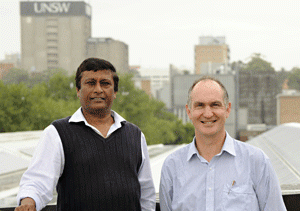Cutting our carbon footprint
Roofing materials that double as solar panels and can also moderate the temperature of buildings are among the next-generation building products being developed at UNSW.
Roofing materials that double as solar panels and can also moderate the temperature of buildings are among the next-generation building products being developed at UNSW.

Roofing materials that double as solar panels and can also moderate the temperature of buildings are among the next-generation building products being developed at UNSW.
A prototype of a photovoltaic/thermal system has already demonstrated that it can produce warm air at 25 degrees throughout winter. The technology, developed by UNSW’s School of Photovoltaic and Renewable Engineering, will be integrated into roofing panels.
It’s part of a series of ‘carbon-positive’ products that will be tested and further developed by the Cooperative Research Centre (CRC) for Low-Carbon Living at UNSW this year.
“A lot of people aren’t aware that the biggest opportunity for emissions reductions is in buildings,” says the head of the new CRC, Professor Deo Prasad, who is part of the Faculty of Built Environment.
“The built environment is responsible for 40 per cent of energy use and Australia’s homes account for 16.5 per cent of our emissions in electricity use alone, without accounting for energy embodied during the production and disposal of building materials.
“Unless we have carbon-positive products, it will be difficult to have carbon-positive buildings,” Professor Prasad says.
“The idea is that instead of simply putting solar cells on top of regular roofs, they are integrated, so that the minute the metal roofing is installed, it starts to pay back its carbon debt by pumping power into the grid and providing warm air in the winter,” says the CRC’s Program Leader for Integrated Building Systems Associate Professor Alistair Sproul, who is also developing a thermally-driven air-conditioner.
Professor Prasad says the CRC aims to come up with further green innovations, as well as design and planning solutions to help reduce our carbon footprints.
The products will be tested from late 2012 in so-called “living laboratories”, one of which is located in the recently constructed Tyree Energy Technologies Building, built by Brookfield Multiplex, one of the CRC’s major industry partners, at UNSW’s Kensington campus.
Professor Dennis Else, General Manager for Sustainability, Safety and Health at Brookfield Multiplex said the challenge of building and retrofitting for lower carbon outcomes is in practice a great opportunity to create buildings that not only consume less energy but also deliver measurably higher human performance in terms of health, collaboration and productivity.
Other “living laboratories” are the city of Newcastle, the industrial area of Docklands in Melbourne and the residential area of Lochiel Park in Adelaide. Residents and workers will test the effectiveness of these products and changes will be incorporated into the design process.
These products are aimed to prepare Australia for a zero carbon building code, which is being introduced in the UK and Europe in 2016.
The CRC has been funded by the federal government with support from industry.
Media contact: Susi Hamilton, UNSW Office of Media and Communication, 0422 934 024